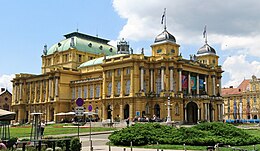Croatian National Theatre, Zagreb
 From Wikipedia the free encyclopedia
From Wikipedia the free encyclopedia
 Croatian National Theatre building in Zagreb | |
 | |
| Address | 15 Republic of Croatia Square Zagreb Croatia |
|---|---|
| Owner | Republic of Croatia (51 %) City of Zagreb (49 %) |
| Type | National theatre, opera and ballet house |
| Capacity | 715 |
| Construction | |
| Broke ground | 22 May 1894[1] |
| Opened | 14 October 1895[1] |
| Renovated | 1937 1967–1969[1] |
| Architect | Fellner & Helmer |
| Website | |
| www | |
The Croatian National Theatre in Zagreb (Croatian: Hrvatsko narodno kazalište u Zagrebu), commonly referred to as HNK Zagreb, is a theatre, opera and ballet house located in Zagreb.[2]
Overview[edit]

The theatre evolved out of the first city theatre opened in 1834 housed in the present-day Old City Hall.[3] The theatre was first established as the Croatian National Theatre in 1860, and in 1861 it gained government support putting it on par with many other European national theatres. In 1870 an opera company was added to the theatre and in 1895 it moved to the new purpose-built building on Republic of Croatia Square in Zagreb's Lower Town, where it is based today.
Austro-Hungarian emperor Franz Joseph I was at the unveiling of this new building during his visit to the city in 1895.[1] The building itself was the project of famed Viennese architects Ferdinand Fellner and Herman Helmer, whose firm had built several theatres in Vienna. Celebrations marking the 100th anniversary of the building were held on October 14, 1995.
At the entrance of the theatre is located the wall fountain The Source of Life (Zdenac života), designed by Croatian artist and sculptor Ivan Meštrović in 1905.[4]
Many of Croatia's leading artist have worked at the theatre.[citation needed] Its first manager and dramatist was the Greek–Croatian poet Dimitrija Demeter, a leading activist of the Croatian national revival movement, with Ivan Zajc as first conductor. Jakov Gotovac was the Theatre's opera conductor from 1923 to 1958. The famous Croatian theatre director Branko Gavella began his career here, as did the first Croatian prima ballerina Mia Čorak Slavenska. A notable comic opera Ero s onoga svijeta premiered in this theatre in 1935.
The theatre has also seen many international artists including Franz Liszt, Sarah Bernhardt, Franz Lehár, Richard Strauss, Gérard Philipe, Vivien Leigh, Laurence Olivier, Jean-Louis Barrault, Peter Brook, Mario Del Monaco, José Carreras.[5]
There are also Croatian National Theatres in Split, Rijeka, Osijek, Varaždin and Zadar.[citation needed]
Due to the ongoing coronavirus pandemic the Croatian National Theater in Zagreb decided, in collaboration with the daily newspaper 24sata, to allow citizens access quality cultural content through a YouTube channel, which will feature daily performances from the branches of opera, ballet and drama.[6]
See also[edit]
References[edit]
- ^ a b c d "Povijest zgrade". hnk.hr (in Croatian). Croatian National Theatre in Zagreb. Archived from the original on 20 May 2016. Retrieved 12 January 2015.
- ^ "Croatian National Theatre in Zagreb". TripAdvisor. Retrieved 4 August 2014.
- ^ "Stankovićevo kazalište" [Stanković's theatre] (in Croatian). enciklopedija.hr. Retrieved 12 March 2021.
- ^ "Meštrovićev "Zdenac života" izložen u Splitu". vijesti.hrt.hr (in Croatian). Croatian Radiotelevision. 3 May 2013. Retrieved 9 February 2017.
- ^ "Povijest". hnk.hr (in Croatian). Croatian National Theatre in Zagreb. Archived from the original on 23 December 2016. Retrieved 9 February 2017.
- ^ "Produkcije HNK-a Zagreb od srijede online na YouTube-u". tportal.hr (in Croatian). 17 March 2020. Retrieved 20 March 2020.
External links[edit]
- Official website (in Croatian)
